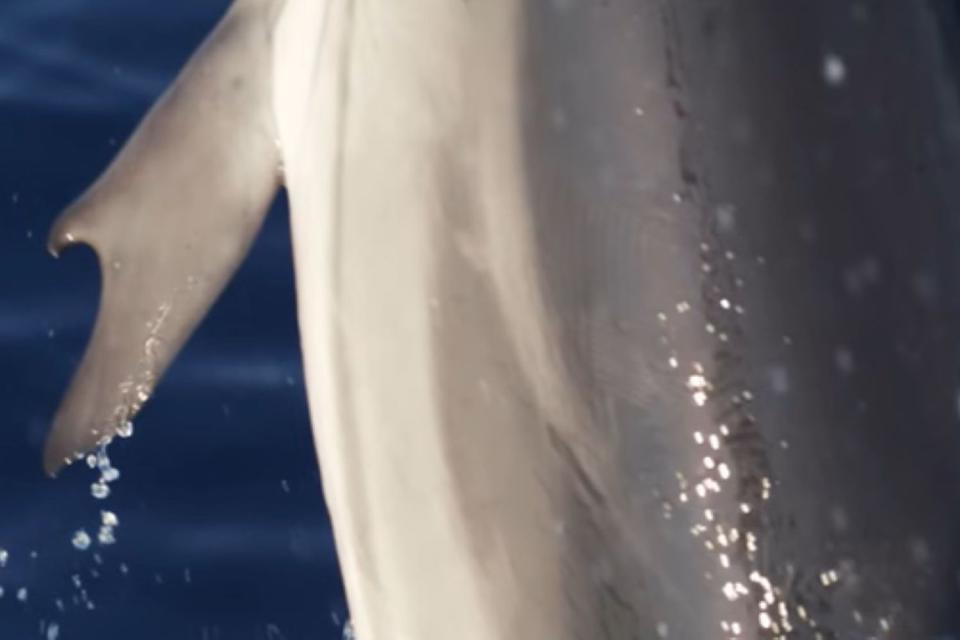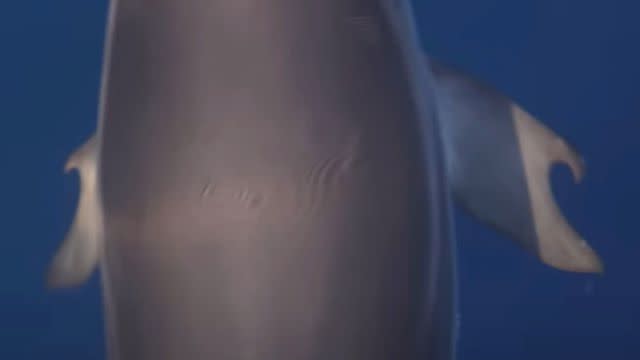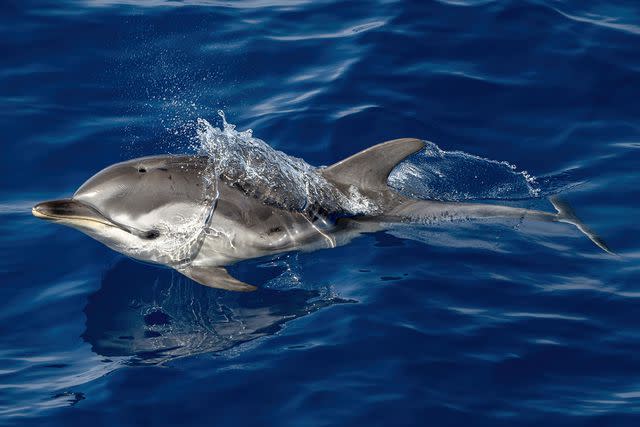'Unique' Dolphin with 'Thumbs' Spotted by Researchers in Greece in Rare Discovery
"It is lovely to see that this animal is thriving," anatomy and neurobiology professor Lisa Noelle Cooper told Live Science of the striped dolphin

Alexandros Frantzis/Pelagos Cetacean Research Institute
Close up of the thumb-like flipper documented on a striped dolphin in the waters around GreeceA dolphin spotted off the coast of Greece stuck out from their pod like a sore thumb!
The striped dolphin, which has flippers that resemble thumbs, was spotted twice this summer in the Gulf of Corinth, Live Science reported.
The rare creature was spotted and photographed by researchers with the Pelagos Cetacean Research Institute (PCRI), a scientific non-profit focused on the study and conservation of cetaceans (whales, dolphins, and porpoises).
The PCRI first reported the sightings in October while sharing the results of recent boat surveys in a YouTube video.
“We recorded a unique striped dolphin with thumbs on both its pectoral fins,” the institute wrote in the video description.
Related: Casper the Rare White Dolphin — One of Only Three in the World— Appears in California
According to Alexandros Frantzis, the president of the PCRI who captured the photos of the rare dolphin, this was not only a "unique" sighting — it was something the institute had never seen before.
"It was the very first time we saw this surprising flipper morphology in 30 years of surveys in the open sea and also in studies while monitoring all the stranded dolphins along the coasts of Greece for 30 years," Frantzis told Live Science via email.

Alexandros Frantzis/Pelagos Cetacean Research Institute
Close-up photos of the thumb-like flippers documented on a striped dolphin by the Pelagos Cetacean Research InstituteDespite the creature's rare, thumb-like flippers — which "[do] not look like illness at all," per the researcher — it was able to keep up with the rest of their pod, "swimming, leaping, bow-riding [and] playing" with other dolphins, he said.
The Gulf of Corinth, the semi-enclosed inlet of the Ionian Sea, is the permanent home of about 1,300 striped dolphins who are isolated from the rest of the Mediterranean population, according to the Marine Mammal Protected Areas Task Force.
The dolphin's "thumb" flippers may be "the expression of some rare and 'irregular' genes" that arose because of interbreeding in the isolated dolphin population, Frantzis told Live Science.
Related: Football-Sized Goldfish Have Invaded the Great Lakes: They 'Eat Anything and Everything'
Lisa Noelle Cooper, an associate professor of anatomy and neurobiology at Northeast Ohio Medical University (NEOMED), also spoke with the outlet and agreed with Frantzis' theory that the thumb-like flippers are linked to the marine mammal's genetics.
"I've never seen a flipper of a cetacean that had this shape. Given that the defect is in both the left and right flippers, it is probably the result of an altered genetic program that sculpts the flipper during development as a calf," said Cooper, who studies mammal bone structure, per her NEOMED bio.

Getty
A stock photo of a striped dolphinNever miss a story — sign up for PEOPLE's free daily newsletter to stay up-to-date on the best of what PEOPLE has to offer, from juicy celebrity news to compelling human interest stories.
Whereas humans' fingers are fused into hands in the womb with cells that die off before birth, dolphins' flippers are formed by cells that accumulate around their forelimb bones, per Cooper.
"Normally, dolphins develop their fingers within the flipper, and no cells between the fingers die off," she told Live Science.
Related: Gray Whale Gives Birth in Front of Boats Filled with Amazed Onlookers in California — Watch!
Cooper said that the "hook-like" flipper formation observed in the unique dolphin from the Gulf of Corinth — where just the thumb and fourth finger remain — appears to be the result of missing tissue and missing finger bones.
"It looks to me like the cells that normally would have formed the equivalent of our index and middle fingers died off in a strange event when the flipper was forming while the calf was still in the womb," she told the outlet.
Of the creature's "thumb," she said it "may have some bone inside of it, but it certainly isn't mobile," noting that "no cetaceans have mobile thumbs."
Added Cooper: "It is lovely to see that this animal is thriving."
For more People news, make sure to sign up for our newsletter!
Read the original article on People.


